Forums
Big Day
Post a reply
- Go to Previous topic
- Go to Next topic
- Go to Welcome
- Go to Introduce Yourself
- Go to General Discussion
- Go to Screenshots, Images and Videos
- Go to Off topic
- Go to Works in Progress
- Go to Skinning Tips / Tutorials
- Go to Skin Requests
- Go to IJAAF Library
- Go to Luftwaffe Library
- Go to RAF Library
- Go to USAAF / USN Library
- Go to Misc Library
- Go to The Ops Room
- Go to Made in Germany
- Go to Campaigns and Missions
- Go to Works in Progress
- Go to Juri's Air-Raid Shelter
- Go to Campaigns and Missions
- Go to Works in Progress
- Go to Skinpacks
- Go to External Projects Discussion
- Go to Books & Resources
-
13 years ago
 Main AdminOn January 14, 1945, the 357th Fighter Group shot down 56.5 German fighters during a single mission.
Main AdminOn January 14, 1945, the 357th Fighter Group shot down 56.5 German fighters during a single mission.
Lt. Col. Irwin Dregne was leading the group in his Mustang ?Bobby Jeanne,? escorting the first three boxes of bombers, when he spotted two large groups of contrails, obviously fighters massing for an attack from 1 o?clock. ?I led Greenhouse Squadron (the 364th) toward the contrails, instructing the other two squadrons to stay close to the bombers. As I got closer to the contrails, I noticed a large gaggle coming in at our level, which turned out to be Fw 190s flying company front formation in waves of eight. The contrails I first spotted were Bf 109s giving top cover.?
The 364th?s Blue Flight Leader, Maj. John Storch, was astonished to see the top cover separate from the Fw 190s, ?and we were able to make a diving turn onto the tails of the 190s as they passed under us without worrying about their top cover,? he said.
Dregne ordered the 364th to drop tanks, ?and we turned into the 190s. The 190s broke formation and scattered, some of them rolling, some split-S?ing, but the majority broke right and then went into a Lufbery. I got my sights on a 190 and strated firing, observing strikes on the fuselage and tail. He broke left and then went into a spin. I broke left and continued turning, finding myself in a Lufbery with eight or 10 Fw 190s. I started a tight climbing spiral, the 190s following, but I was able to outclimb them. My flight was broken up on the initial attack by the enemy flying through us. I noticed a bomber box under attack, so I started climbing toward it. When I got to the box, the fight was over and the Huns had left. I picked up a P-51 and told him to be my wingman.?
This was Lt. Col. Andy Evans, the deputy group CO; Evans had already shot down an Fw 190 and a Bf 109, then flew another Fw 190 into the ground, then climbed after another Fw 190 which abruptly collided with a fifth German plane.
?We went to the front of the force and started escorting again,? Dregne continued. ?My wingman informed me he was low on gas so I set course for home. I then spotted a Bf 109 below me at 20,000 feet. I chopped my throttle, slid in behind it and started firing. I observed strikes around the cockpit, and the plane started smoking and burning, spinning down. The Bf 109 crashed.?
Storch singled out his own Fw 190 and his opponent broke for the deck. ?I followed him from 24,000 feet to 2,000 feet straight down, firing intermittently,? he said. ?He was taking wild evasive action. I did not think I was hitting him at all, but at 12,000 feet smoke began to pour out of the enemy aircraft. I had to break off as my plane was out of control due to air speed in excess of 500 mph. As I broke off, my wingman observed black smoke coming from the enemy aircraft and saw him go into the ground.?
As Storch recovered from his dive, he spotted a fight below him and led his wingman over. ?I singled out an Fw 190 on the outside of the scrap and he went for the deck. I followed, and at this point my wingman observed an Fw 190 firing at us and had to break off to take care of him, which he did to the tune of one Fw 190 destroyed. In the meantime, my Fw 190 was going balls out on the deck. I had enough excess speed to pull up behind him and fired for some time with no effect. I finally managed to get close enough so I couldn?t miss and saw the strikes center on the fuselage and left wing. He burst into flame and suddenly snap-rolled, and large pieces flew off. I overshot, and he went into the ground burning; I did not observe the pilot get out before he hit the ground. I pulled up and my wingman pulled off his 190, and we rejoined and started to climb back to the bombers.?
Before they could regain altitude, they spotted two Bf 109s below them and dived to attack yet again. ?They separated and hit the deck,? said Storch. ?I picked one and chased him for about five minutes. I finally caught him and he went into a turning circle. My gunsight had burned out and I was a picture of confusion trying to turn, fire, fix my sight, put down flaps, pull up flaps and work my throttle. Finally, after giving up on my bad gunsight, I once again got close enough so I couldn?t miss and got strikes; coolant and smoke came from the enemy aircraft. He tried to belly in just short of a forest, hit and bounced almost over into a clearing but hit the last few trees on the fringe of the forest and the pieces scattered into the clearing.?
Meanwhile, White Flight of the 364th Fighter Squadron dove into the same mass of fighters, reported as ?150 Fw 190s with 109s as top cover? by Capt. Thomas H. Adams. ?There were so many fighters it was hard to pick a single target, but I caught one coming head on and gave him a burst as he came by but didn?t get strikes. I swung around and latched on and he gave me a good demonstration of snap rolls, etc., then went into a rolling dive for the deck. My airspeed was past 450 mph and I was almost in the ?walking stick? stage when the 190 snapped and disintegrated. He went into the ground and exploded. No chute was seen.
?As I pulled away, I lost my wingmen and was trying to pick them up when I noticed a lone plane circling around all alone. He was so far away that I couldn?t distinguish much except the black smoke trail and I knew he was a Jerry. No one else was in the area, so I started after him, and by this time he had set a northeasterly course and hit balls out for home. Situating myself between him and the sun, I poured on the coal and proceeded to either catch him there or over his field because he was the only one lacking from my big ?five.? I chased him for about 15 minutes, cursing and raving because I thought I was never going to catch the bastard. Apparently, he thought he was safe because he throttled back and settled down for a nice ride ? to hell. I closed and had to put down full flaps in order not to over-run him. My first burst hit him in the port wing root and he sort of turned as if to look behind him, but I was still between him and the sun and he leveled out again. This time I turned on the heat, getting hits in the cockpit, blowing his canopy off, and he turned on his back and went straight in from 10,000 feet. He did not get out. I would have taken pictures of the crash but light flak kept me on the move.?
Blue Flight?s Lt. Paul Hatala dove on the enemy formation with his flight, then climbed with two Fw 190s that were foolish enough to start up toward the bombers. ?I closed into range and one broke away as I fired at his wingman,? said Hatala. ?I observed strikes and he burst into flames and went down spinning. I didn?t follow because the other Fw 190 came back and I started turning to the left with him. I fired and got strikes on him. He then split-S?ed and went down to the deck. I followed him, and after he did a couple of maneuvers I got into position and gave him another burst of fire. He burst into flame and I saw him crash into the ground on fire.?
Yellow Flight was down to two planes because of aborts, and Yellow Leader, Lt. Robert Winks, lost his wingman in the initial turn toward the fighters. ?I found myself making a head-on pass at an Fw 190, guessed the bead, fired and observed many strikes on the engine, cockpit and left wing root,? Winks said. ?I wheeled around just in time to see the left wing collapse up over the canopy, evidently as a result on the enemy aircraft?s reefing it in with a badly damaged wing. I didn?t see the pilot get out.?
Winks circled to gain altitude and soon encountered another Fw 190 trying to make a head-on pass. ?He was damned aggressive, so we started our affair with another head-on pass,? Winks said. ?Neither of us fired as I remember it. Soon we found ourselves S-ing back and forth on a common course, chopping throttle, adding throttle and dropping flaps, both trying to get the advantage. A sad situation! Finally, I out-S?ed him, got on his tail, fired and watched as he obligingly blew up.
?By now, I was sure that being alone was nor the preferred thing, so I began searching for other friendly aircraft while I climbed back to the bombers. I joined several and continued climbing. As we reached the bombers, a single Bf 109 was making an attack. I covered as the leader shot him down. I didn?t recognize the group colors on said leader. I then heard Dryden say he was with the bombers over the target, so I went alone to join my squadron. At the target I saw a lone Bf 109 several thousand feet below me with another lone Fw 190 several thousand feet below me. I thought it was a trap, so cautiously I began to drop down on the Bf 109. He saw me coming and broke into me, whereupon I fired in another head-on pass and observed many strikes between the cockpit and tail. He lost control and started spinning. The 190 had made a turn and was now directly over us so I kept an eye on each. Soon I decided that the Fw didn?t intend on coming down so I lit out for the 109, who had since regained control. It took me some time to close on him as he was quite far below by this time. He started a turn to the left and as soon as my range was correct I gave him a rather long burst, observing a few strikes on the left wing. As soon as I had let up on the trigger his tail disintegrated, and a yellow-nosed P-51 shot through my sights. I closed along with the yellow nose, called him on the R/T and continued on out with him as I was low on gas.?
Lt. Dale Karger, flying in Green Flight of the 364th, called in bandits at 12 o?clock high, specifically ?a jet (Me 262) bouncing our flight, and that he was firing at the No. 2 man,? said Lt. Raymond Bank. ?The enemy aircraft overshot and made a slight turn to the left. I turned on my gun switches and pulled my nose up and fired at the Me 262, observing no strikes, and then rejoined my flight. The Me 262 kept on going and disappeared from sight. Capt. Chester Maxwell got on the tail of some 25 to 30 Fw 190s and a Lufbery to the left began.? Maxwell had been so eager to break up this group?s attack that he had simply peeled off and dived in among them without radioing the rest of his flight ?and was forced to engage this gaggle alone,? he said. ?As I approached the formation, part of them broke to the left and the remainder split-S?ed toward the ground. None, I believe, reached the bombers. I got a 20-degree deflection shot in on one of the Jerries who broke to the left. I noticed several strikes around the center of the fuselage and wing root. He started down, out of control and smoking . Almost immediately, one wing came off and he burst into flames.?
Bank had entered the Lufbery, and ?the 190s got on my tail and one was firing at me but I received no hits. I broke into him and as he overshot me I closed to about 100 feet and set him on fire. I did not observe the pilot bail out.
?I then jumped the other Fw 190 and shot him down in flames. At first, several pieces came off and then he caught on fire. No pilot was seen to come out of the plane. Flying to rejoin my flight, I bounced a 190 which gave me a hard time as I only got a few strikes on him in snap shots. He dove down and came up into a loop; at the top of it, he kicked it into a hammer-head so as to try to make a head-on pass. He was going fairly slowly at the top of it, and as he kicked over he gave me a perfect target. I continued firing until he burst into flames. No pilot was seen to bail out.?
Meanwhile, Karger had also begun to turn with the Lufbery, and soon a Bf 109 dove for safety. ?I followed,? said Karger. ?I kept getting strikes on him on the tree tops for about two minutes. He then belly landed in a field and caught fire. When I started to make a pass at him, I saw the pilot trying to get out of the burning plane, so I let him have the full effus, which caused the ship to explode and Jerry had it. It?s a rough war.?
Maxwell had been unable to reform the flight because of ?excessive chatter on the R/T,? so he continued fighting alone. ?I spotted 12 more 190s making a pass on the rear element of bombers from about 5 o?clock,? he said. ?I bounced them and the entire group made a diving urn to the left, failing to penetrate the bombers. I climbed on another Jerry?s tail, gave him one long burst and he flopped out of control, hit the ground and burst into flames.
?There was a fight going on down below me. I dove and attacked another 190 who was on the tail of a black-nosed P-51. This was at about 6000 feet. I fired on him from 60 degrees on a head-on pass, closing to about 100 yards. I observed good strikes and the pilot bailed out.
?I then observed a single 190 attacking the bombers. I pushed everything forward. He split S?ed and I followed him down, gradually closing. At about 12,000 feet, I looked back and saw another P-51 trailing me. Confident that I had my tail covered, I pressed the attack. The next thing I knew, I felt strikes on the plane and my canopy was shot off. I tried my radio and evidently it was shot up as it was not working. I observed several strikes on my right wing. The clobbering I got evidently cut the aileron cable as my ship went out of control. The ship handled sluggishly. My coolant gauge needle went up to 150 degrees and the engine began to smoke and I figured he had also shot out my coolant. The P-51 then closed and I saw it to be a yellow-nosed job (probably from the 361st FG). He made no further passes at me but flew off.
?I cut my engine and put the plan in a shallow glide. I cut it back in at about 6000 feet, using 1000 RPMs and 322 inches of Mercury. I figured I didn?t have a chance in Hell of getting back as I was about an hour and a half from friendly territory.
?Two other ships in my group flew up and investigated me and apparently thought I was okay, although the canopy was off and belts of ammunition were hanging out of the wing. I made it back to Antwerp with low RPM and low manifold pressure, arriving there at tree-top level, and bellied the plane into an English Army parking lot.?
After reaching the fight, Green Flight of the 362nd Fighter Squadron moved in and Lt. John Kirla scythed through the enemy fighters. ?I picked out an Fw 190 which was attacking the bombers and closed in to about 100 yards before I opened fire,? he said. ?I clobbered him all over. I believe I killed the pilot. I watched him dive inverted into the ground and explode. My second Fw 190 was in a dogfight. I closed into range on him and started to fire from about 400 yards, closing to about 50 yards, getting strikes all over him. He began to tumble and I watched him go into the ground.?
Kirla?s wingman, Lt. ?Jack? Dunn, was no longer with him; concerned about fuel, he had conserved the load in his fuselage tank and, when Kirla turned into his first victim, Dunn snapped violently and tumbled downward. When he reined the Mustang in, he spotted a single Bf 109 creeping up on him from behind; he turned into the fighter and again snapped, this time recovering just above the trees. Before the 109 could take advantage of him a flight of four more P-51s dove in and sent the German fighter crashing to earth.
Meanwhile, Kirla was still busy. ?I looked around for another target and saw a Bf 109 shooting down a bomber. I went after him. I got on his tail and closed to about 30 yards. He went into a very tight barrel roll going straight down. I fired a short burst, getting strikes, and he straightened out. Then I really gave him the works, clobbering him all over. He flipped over on his back and started to burn. Pieces fell off the ship until, finally, just the framework remained. I laughed and commented to myself on the crazy contraptions they were sending up these days. There wasn?t enough of this ship left to crash into the ground.
?Looking around again, I observed two Bf 109s flying 180 degrees to the bombers and a P-51 chasing them. The P-51 closed in and got the first Jerry, but meanwhile the second one was sliding onto the Mustang?s tail. The Mustang was shot down. I was at close enough range by this time to get some revenge,? said Kirla. ?I began firing at about 200 yards and played with him a while. He was badly scared. I got tired of that and adjusted my K-14 and opened up at about 50 yards. I filled him full of holes. Pieces started to fly off him and he went down like a falling leaf.?
Lt. George A. Behling in P-51D-15 44-15527 ?Chi Lassie? was element leader in Kirla?s Dollar Green Flight, and when the 362nd dropped tanks and dove to attack, his wingman, Lt. James Gasser, blacked out because his ?G? suit rubber hose connection had come loose. Behling took a bead on an enemy fighter, but another P-51 cut him off, ?so close I still don?t know why I didn?t tear its tail off with my propeller,? he wrote later. The distracted Behling lost sight of his quarry, and as he tried to spot the German plane he realized an Fw 190 had slipped onto his tail. With no wingman, Behling went into a hard turn to the left to shake the Fw 190; he could see tracers and cannon rounds sailing past him. He recalled wondering to himself, ?what am I doing here? A person could get killed!? Behling continued to reef the turn in when suddenly the stick went limp ? he had spun the Mustang. He corrected the spin at 20,000 feet only to discover the German fighter was still on his tail, so he went into a dive and firewalled the engine. Sure enough, Behling quickly out-ran the Fw 190 ? but then, just as he passed the Elbe River, his engine sputtered, then began streaming white smoke, then seized completely. Over a thick forest, he thought about bailing out but didn?t have enough altitude. Luckily, an open field parallel to a railroad track was to his immediate left; he lined up the field but then, at the last second, saw it was crossed by a set of high-tension electric lines. Behling?s Mustang hit the frozen ground, bounced up and over the power lines, and came back down, sliding to within 50 feet of some trees before stopping. When he opened the canopy, he heard the sound of an aircraft ? it was the Fw 190 coming right at him. Panicked, he tried to leap from his plane, but the straps were tangled in the cockpit, so he crouched behind the armored seat plate. The Fw 190 did not fire and instead zoomed away. Behling managed to get out of the plane and headed for the tree line, but was soon captured and became a POW.
Lt. John Sublett was leading Yellow Flight when, at about 27,000 feet northwest of Berlin, ?Someone called in a huge number of Huns coming from the south,? he reported. ?I turned with the squadron and started in that direction. I saw them all at once. There was a long line of Bf 109s in no particular formation, except a sort of long column containing six to 10 abreast. They were to the left of me (at) about 300 yards, going 180 degrees opposite (to my course). They totaled at least 100. To my right and above were several Jerries doing snaps, rolls and spins. I called my wingman (Lt. William R. Gruber) and told him that when they finally got through passing by we would tack on to their rear end and start shooting. It seemed an endless procession, but finally they passed by and I tacked on to their tail end. The last four Bf 109s then broke into us. We started a honey of a Lufbery which went about six turns. I finally cut the butter and got a short burst into one of them. I was going straight down when I fired from about 100 yards, seeing many strikes right into the pilot through the top of his canopy. The plane went out of control and crashed into the ground. The pilot, who, I am sure, was dead from my fire, did not bail out.
?I reefed upwards and went after another Bf 109 who was at the tail end. He flicked over and started down. I followed. I opened fire from about 700 yards but saw no strikes. I continued to follow him straight down, expecting him to pull out, but he did not recover. He hit the ground and exploded. The pilot did not get out.?
The other two members of Yellow Flight, Lt. Jesse Frey and Lt. Herman Delanger, climbed to hit the cover flight. ?Lt. Delanger, leading the element, decide to engage the two flights of top cover for the enemy gaggle,? said Frey. ?These planes did a 180-degree turn and began flying southeast. Lt. Delanger climbed behind the first four; I believe he fired at them but I observed no strikes. Then I discovered that two Bf 109s were flying 1500 yards behind us, slightly above. I called Lt. Delanger and told him to turn left. We came around behind these two. One broke off to the left and Delanger followed, but could not get into position to fire. I called and told him to cover me as I went after the 109, continuing his turn to the left. I closed to maximum range and shot a burst of three seconds, observing strikes on the wings and cockpit. The enemy plane fell over, out of control, and hit the ground, exploding on contact. The pilot did not bail out.?
Meanwhile, White Flight of the 362nd (a six-plane flight, because Maj. John England and Maj. Joseph Broadhead had joined after their wingmen aborted) plowed into a ?large gaggle of fighters which were preparing to attack the bombers,? said Broadhead. The enemy aircraft seemed to hesitate in making an initial attack,? said England. ?They made several orbits as though they were sizing the situation up. This was to our advantage. While they were debating, I placed my squadron in the proper position while at the same time headed towards the enemy aircraft, hoping to break up the gaggle before they could attack the bombers. They did start and attack before I could get to them, but we interfered slightly and engaged the Krauts in individual dogfights.?
Lt. Harold Wyatt picked up one Fw 190, closed to 300 yards, and fired, :getting strikes all along his left wing and fuselage,? Wyatt said. ?When the Jerry pulled up to the left I gave him another burst right in the cockpit. He started smoking and began tumbling earthward. I watched it hit the ground and burn.?
One Bf 109 slipped through the fighter cover and headed for the bombers. England got on his tail, but he was out of firing range. ?The pilot displayed a little judgment by looking around,? said England; ?then he put his ship in a 90-degree vertical dive from 32,000 feet. I followed him down. At about every 5000 feet during the descent, he would roll and do some very violent evasive maneuvers. I just did a tight spiral around him. At 8000 feet, he made a very tight pull-out and leveled off. Evidently, the pilot thought he had lost me, for he began flying straight and level. Maybe he didn?t realize the speed of the .50 caliber bullet and decided to take time out for a decision. I made a little tighter pull-out and started firing at 200 yards, closing to 50 yards. I got strikes all over the left side of the fuselage and left wing. Just before I released the rigger, about four feet of the left wing ripped off. The pilot did not get out as his ship went into the ground, making a big explosion. The pilot had been fair, but he had made the usual mistake which prevents fair pilots from becoming good pilots.?
Broadhead had covered England all the way down. ?While we were re-forming, an Fw 190 got on my tail, but Lt. Cheever came to my rescue and shot him off,? Broadhead said. The German pilot was so intent on Broadhead that he flew right in front of Cheever, who was leading Red Flight. ?I pulled out to the left and let all the planes go by,? he said. ?As the Fw 190 passed me, I slipped in behind him and began firing from about 100 feet, continuing to fire until I was forced to break away to avoid hitting him. I saw strikes on the tail, wings and fuselage. The enemy ship rolled and headed for the deck. He did not pull out of the dive but went straight into the ground.?
After Cheever dispatched Broadhead?s pursuer, White Flight re-formed and Broadhead spotted a lone Bf 109. ?I attacked him from the rear, firing lots of ammo, hitting him in the tail, fuselage, wings, engine and the side of the cockpit. Pieces started coming off the enemy ship, then the canopy came off and the pilot bailed out. I almost rammed the pilot as I passed him. The ship crashed and burned.?
Capt. Leonard ?Kit? Carson?s Blue Flight was busy, too. As soon as they spotted the fighters preparing to hit the bombers head-on, ?we pulled out in front of the bombers and met them in a head-on attack,? said Carson. ?I took Blue, Green and Yellow Flights to the left to break up the attack at 11 o?clock. I fired at them, as did most everyone else, coming head-on, then turned and tacked onto the rear of the gaggle. Their attack on the bombers had been diverted, so we concentrated on the tail-end Charlies. I closed to about 400 yards on an Fw 190 at the rear on the outside, firing a good burst, getting strikes all over his fuselage. I watched him for a second to see his reaction. He took no evasive action, but just peeled down to the right very slowly. I followed him down. His turns became more violent and then he started snapping from the right to the left. He was smoking quite badly. I believe the pilot was killed. I pulled off and watched him until he hit the dirt.?
Meanwhile, another pilot in Carson?s flight, Lt. John Duncan, picked another Fw 190 to the right of Carson?s victim. ?I opened fire from 600 yards, closing to 200 yards, getting strikes on both wings,? he said. ?The Jerrys split-S?ed for the deck and I followed him down, firing some more and getting additional strikes. At about 18,000 feet, the pilot bailed out and I watched his chute open.?
When Duncan looked around, he saw none of his squadron members, or any P-51s for that matter. What Duncan did spot were eight Fw 190s approaching him from the rear. ?They pulled off to the right, and I reversed my turn and went left,? he said. ?I met them head on and managed to get inside the last man, turning in the opposite direction. We were at 15,000 feet altitude. I fired and saw strikes all over the canopy. He started streaming smoke and then dove straight down. I watched him go down in a slow spiral, still streaming smoke, it the ground and exploded. The pilot did not get out.?
While Duncan had descended, Carson and the two remaining members of his element had climbed. ?I went back up to the bombers, looked around for a couple of minutes, looked straight back at 6 o?clock and saw a formation of 40 to 50 Fw 190s coming up about 1000 yards behind,? he said. ?There were a couple of P-51s near me, and they broke with me. We met the enemy planed head-on. They didn?t fire, but we did, although I saw no hits. After we got behind them, we turned as quickly as possible and once again picked out a tail-end Charlie. I fired a burst at 350 to 400 yards at an Fw 190, getting strikes, He did a couple of snaps to the right, with his belly tank on, and wound up on his back. I fired again, getting more hits on the fuselage. Pieces came off the enemy ship and he began smoking. He split-S?ed and headed for the deck. I followed him down until he hit, bounced and crashed. The pilot did not get out.
?I climbed back up to about 14,000 feet when two Bf 109s came tooling by about 2000 feet beneath me. I dropped down and fired at the one in the rear, getting no hits. They dropped flaps and broke violently. I zoomed back up while they circled in a Lufbery. I made another ill-timed pass and pulled up again, getting no hits. The leader broke off and headed for the deck. I dropped down to tail-end Charlie as he started down. He pulled up, losing speed. I kept my excessive speed, firewalled it, and started firing at about 300 yards, closing down to about 20 yards, getting hits all over the fuselage. His coolant blew as I pulled over him. Then he went into a sort of tumbling spiral and crashed.?
A Bf 109 dived between Lt. Charles Weaver and his element leader, splitting the two up. While he scrambled to rejoin, he spotted another Messerschmitt whose markings caused him to pause before attacking. The plane was painted olive drab, with black and white stripes around the fuselage ? perhaps ?Defense of the Reich? bands, but ones Weaver instantly thought of as ?invasion stripes.? He turned onto the Bf 109?s tail and fired a short burst from long range. The Bf 109 responded with a steep left turn. Weaver wracked his plane to draw lead, firing from a nearly inverted position. He saw no strikes, but just the same the Bf 109 dived straight into the ground.
The 363rd had seen the action begin ? ?I saw planes exploding and spinning down in front of us,? said Capt. James Browning ? and raced to join in. The fighters were flying what Capt. Robert Foy described as a ?company front formation of eight ships in each wave. The attacking waves consisted of Fw 190s with Bf 109s flying close escort and above the 190s. Still further enemy cover was affected by Bf 109s flying high and a bit behind the 190s.?
When the Bf 109s dove on the bombers, Foy led his flight to cut them off. ?The 190s broke their company front formation and headed in every direction imaginable,? said Foy. ?I turned to the right and lined up with an Fw 190, closing to a good firing range, giving him short bursts while in a shallow turn and about a 30 degree deflection. Strikes were observed on both wings of the enemy aircraft and he immediately straightened out, flew level for a second or two when suddenly the pilot jettisoned his canopy and bailed out. This action took place at approximately 22,000 feet. I pulled up sharply to avoid colliding with the Hun pilot and as I flew directly over him I observed another Fw 190 flying 90 degrees to my path of flight ad directly beneath me about 3000 feet. I did a quick wingover and split-S?ed onto his tail. The pilot apparently saw me closing in and did a split-S toward the deck. I followed him, giving him short bursts, observing strikes on the left wing. He continued his dive and must have been indicating well over 550 mph as I was following closely behind and was indicating better than 550. He made no move to pull out of his dive, so I started a gradual pull-out at about 4000 feet, but kept his ship in view off to one side. The enemy aircraft dived straight into the ground and I made a 360-degree turn, diving to get a picture of his ship burning on the ground.?
Meanwhile, Browning ?saw a gaggle of 25-plus Bf 109s about 5000 feet below us and to the right of my flight, traveling 180 degrees to us, and they had not been engaged. I led my flight down on them, positioning the flight at the rear of the enemy formation. I picked out a Bf 109 on the right side and fired a burst, observing a concentration of hits on the cockpit and engine. The enemy aircraft did a violent snap roll and then spun down completely out of control. I did not follow him down as the pilot was undoubtedly killed and also because there were many enemy aircraft still in front of me. Meanwhile, a Bf 109 had gotten on my tail, but my wingman, Lt. Taylor, shot him down. I picked out another Bf 109 in front of me and, fired three or four bursts from short range, observing many hits in the center of the fuselage. Again the enemy aircraft went into a violent spin, completely out of control. I then tacked on to another Bf 109, which I followed as he broke right. I fired a short burst and observed hits. He must have been cutting his throttle because I closed on him instantly, but before pulling up over him I fired a long burst as he was crossing in front of me, raking the enemy aircraft the length of the fuselage to the engine with a good concentration of hits. The enemy aircraft rolled over and went down out of control. The entire gaggle of enemy aircraft had been broken up and I could see no more Bf 109s. I climbed back to 24,000 feet with my wingman. I saw a lone Fort pulling out of formation and heading north with two planes circling him. As I could not identify them, I went over to investigate and saw they were Bf 109s. One enemy aircraft then came down behind the Fort and I saw smoke coming out of his guns buy I did not see hits. There was no return fire from the Fort tail gunner. The Bf 109 kept closing and though I was about 900 yards away, I fired a burst to scare him off. All I had left were tracers and I didn?t see any hits, nor did I scare him away. I closed to 500 yards and fired another burst from the one gun I had left, this time observing good hits on him. He broke left and I tracked him with my K-14 sight, firing and getting more hits. The enemy aircraft then went into a spin, but I did not follow him as my wingman said that his engine was very rough. I did see him recover from the spin at approximately 5000 feet (the bastard!). Meanwhile, the other Bf 109 split-S?ed without attacking the lone Fort. The bomber showed no signs of being in distress and no longer in any apparent danger and as my wingman had a rough engine and as I was getting low on gas we set course for home.?
White Flight was being led by Lt. John Stern, and he positioned his four Mustangs behind a like number of Bf 109s that went into a Lufbery. ?I broke into them, picking out tail-end Charlie,? stern said. ?I fired several bursts, observing hits near the cockpit and wing roots. He made a couple of turns. Then he began to snap and spin. Smoke, flame and coolant could be seen; his wheels dropped partially down. Then he pulled up, went over on his back and spun in.?
?Just as it spun out I noticed a Jerry pulling deflection on me, so I broke into him and in about 360 degrees got in a snap shot,? said Stern?s wingman. Lt. George Rice. ?He split-S?ed and I rolled over and followed. I fired another burst and saw a few strikes. I finally got into a good position with small deflection, fired a long burst and saw many strikes in the wing roots and cockpit area. He started streaming smoke and coolant, rolled over and jettisoned his canopy. The last I saw of him, he was headed straight for the ground out of control. I did not follow to watch it hit or the pilot bail out as, at the time, I believed myself to be all alone and the sky was full of Jerries.? Lt. Daniel Myers saw Rice?s victim spin into the ground with the pilot still in the cockpit.
Lt. Raymond Wolf had put several strikes into the wing of a Bf 109 during the initial contact, but was forced to break by fighters approaching him from behind and lost Myers, his wingman. A few minutes later, he saw a P-51 chasing two Bf 109s. ?As I pulled up beside him, he fired a burst,? said Wolf. ?I saw strikes on one of the enemy aircraft. The second enemy aircraft broke away sharply to the left. I followed him in a steep 360-degree turn and fired a short burst. He pulled up into a steep climbing turn. I gave him another burst from about 400 yards.? Myers saw Wolf?s fire ?chew off about two feet of the Bf 109?s left wing.? The Bf 109 went into a flat spin from about 1000 feet, crashed and burned.
Blue Flight was behind White and Red Flights; upon reaching the flight, Blue Leader, William Dunlop, noticed there were Bf 109s up-sun of him. Even so, he dived into the main gaggle below him, passing through two groups of German fighters before pulling up behind another bunch of 30 fighters at about 20,000 feet. He had lost his second element in the dive, but believed his wingman was with him. ?I began firing at the apparent tail-end Charlie which was a Bf 109, and he put his aircraft into a steep dive, kicking rudder violently,? Dunlop wrote later. ?I had to cut my throttle to avoid overrunning and I fired each time he passed through my sites. I hit him repeatedly from wing tip to wing tip, his canopy flew off to the right and the pilot flew out, and just missed my wing as I flew between him and his smoking Bf 109. A fraction of a second later it felt like my guns were firing without me pressing the trigger, and then my controls went out, completely dead. I watched one of my left-hand .50 caliber machine guns blow out through the wing skin and my fuselage fuel tank catch fire. The plane was in a drifting dive and going straight down. The pressure held me in the right of the cockpit and was powerful enough to stop me raising my hand to release the canopy. Then everything blew.?
The wings, canopy, tail section and fuselage broke apart. Dunlop was convinced the canopy had been the first to go because he ?felt the intense heat from the flames that were sucked into the cockpit,? he wrote. ?I was cooked on the forehead and then felt cool air as I was blown from what was left.? At about 5000 feet, Dunlop grappled with his rip cord, pulled it and the chute blossom out from between him and his seat. He swung once and hit the ground. ?I landed still in the bucket seat with the armor plate still attached and my shoulder straps still neatly in place.? The engine and one wing landed together about 50 feet away and other pieces of his Mustang came floating down all around him. Another 100 yards away was the crashed Me 109, ?ammo still popping.? Dunlop walked a short distance before he was captured, and was later sent to Stalag Luft XIII at Nuremburg.
Meanwhile, Stern had lost Rice and his radio malfunctioned, leaving him essentially alone in a swirling dogfight. Stern got onto the tail of another Bf 109; ?the action here was practically the same as the first,? Stern said. ?Many hits were observed around the cockpit and wing roots. His wheels dropped partially. He then started spinning and snapping violently. I fired another burst, observing hits. Pieces came off the plane. I followed him down. Thinking he might be just taking evasive action, I followed him down until he crashed and exploded. It is my belief that the pilot was killed before the crash. I then located my No. 3 and No. 4 men. I saw two Bf 109s in a slight dive for the deck at 9 o?clock. They were flying line abreast. I attacked from dead astern, closing rapidly ? too rapidly. I overshot one and called one of the other boys to take him, which he did. I fired several bursts at the other, which was out of range. As I closed, hits were seen around the bottom of the fuselage, cockpit and wingroots. Coolant and smoke could be seen issuing from the enemy aircraft. I then overran him and pulled up to one side. He then crashed into a woods, tearing off both wings. The plane slid a short way through the trees and caught fire. I think he was trying to belly-land in a small field, but overshot.?
By this time, Foy had climbed back to the bombers and picked up his wingman, breaking escort just west of Steinhurder Lake because his fuel was low and he was almost out of oxygen. ?I took up a heading for base and dropped to about 10,000 feet altitude when I observed a train, which I proceeded to discourage by putting several bursts into the engine,? he said. ?As I pulled off the train, I saw an Fw 190 and gave him chase. I lost him in the ground haze but soon saw an Fw 190 parked to the right of a runway on a beat-up aerodrome. I gave my wingman instructions to fly to the left of the airdrome and pass by it while I dived at the field out of the sun, making a pass at the parked enemy aircraft. I hit him with several good bursts and the aircraft exploded.?
The 363rd lost Lt. James Sloan, who was shot down by a German fighter became a POW, but added single victories by Lts. Glenwood Zarnke and James Windham. In all, the group posted a remarkable score of 56 ? victories, the biggest single day for any U.S. fighter group in the war in Europe.
Two pilots not in on this show were ?Chuck? Yeager and ?Bud? Anderson. This was the last mission of their tours, so they were assigned as spares; not needed, the two broke off, and instead of returning to base flew a low-level tour of the Alps and the area around the Swiss/Italian/German border. This sightseeing meant they were the last to arrive home; after hearing of the exploits of the rest of the group, Anderson?s crew chief rushed to the plane, anxious to know how many his pilot has scored. ?None,? croaked Anderson, who admitted later that when he?d missed out on a record mission, ?I felt sick.?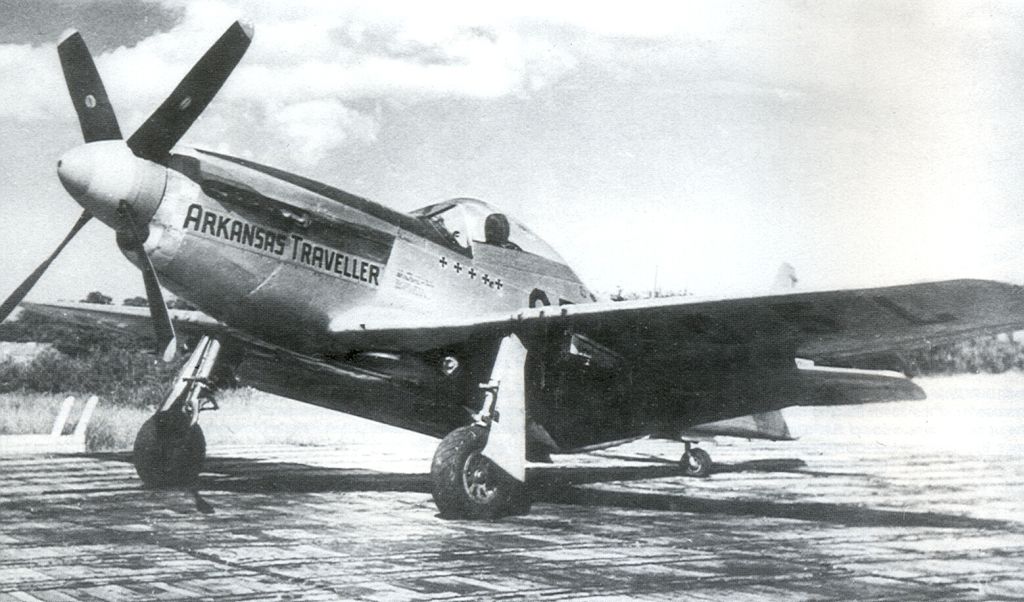
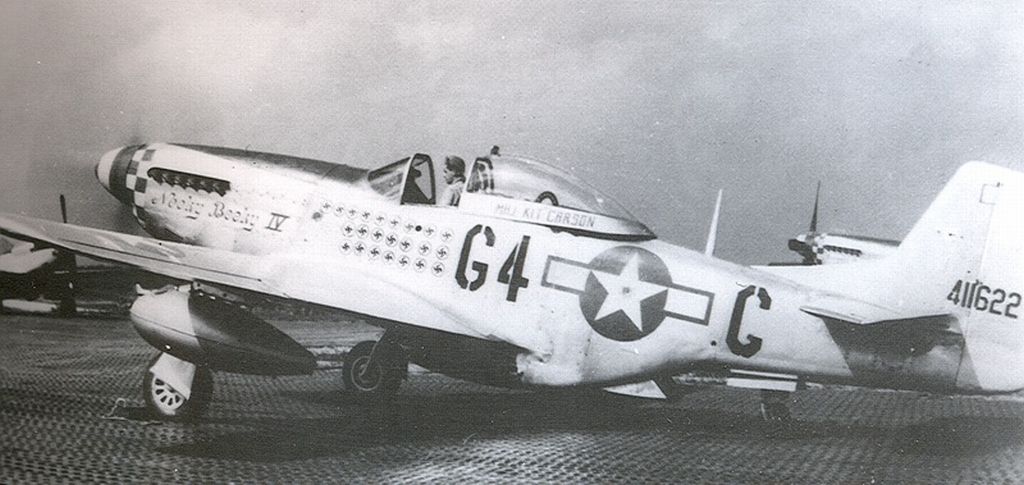
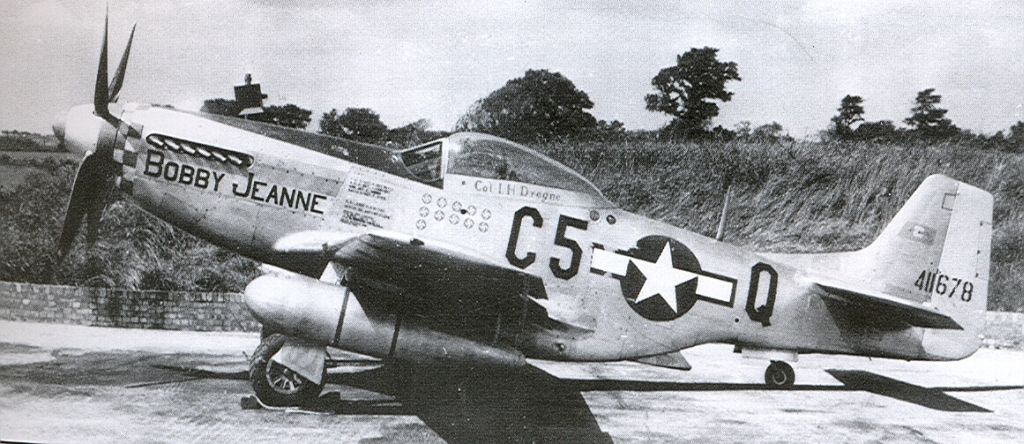
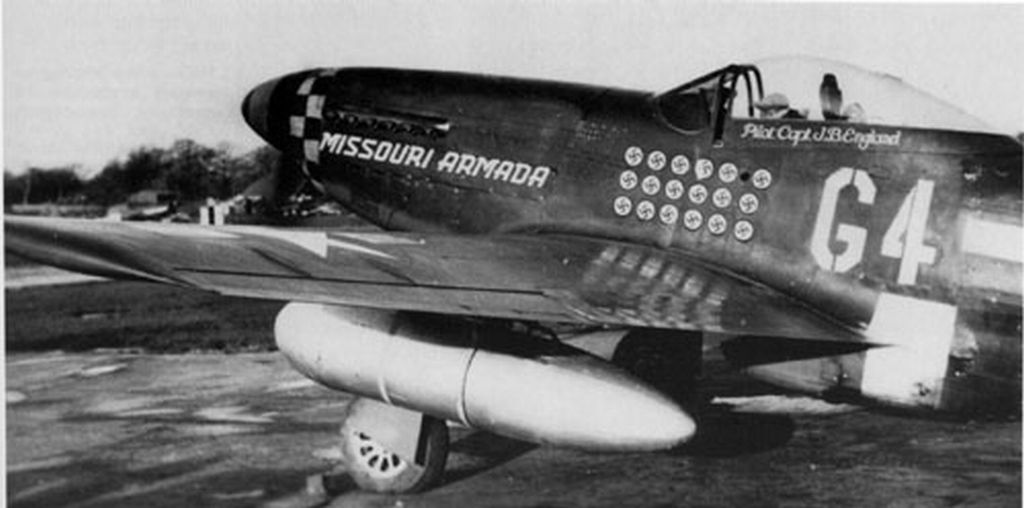
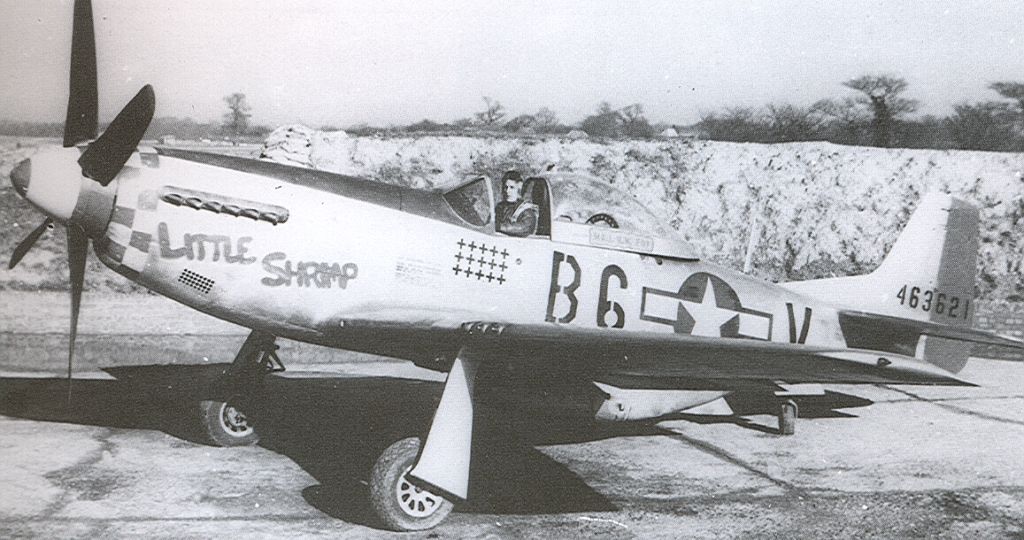
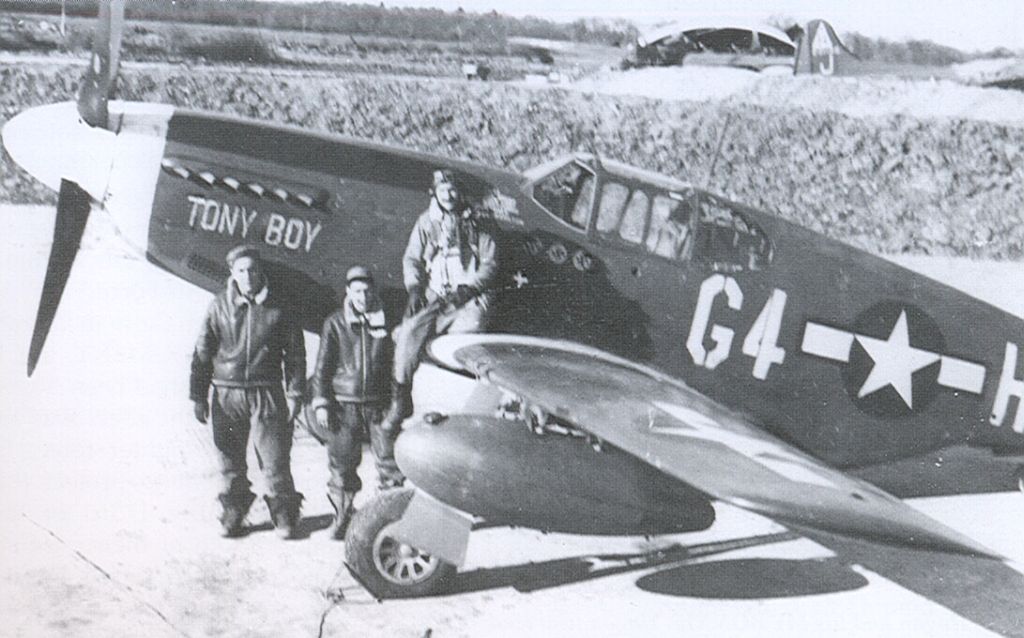
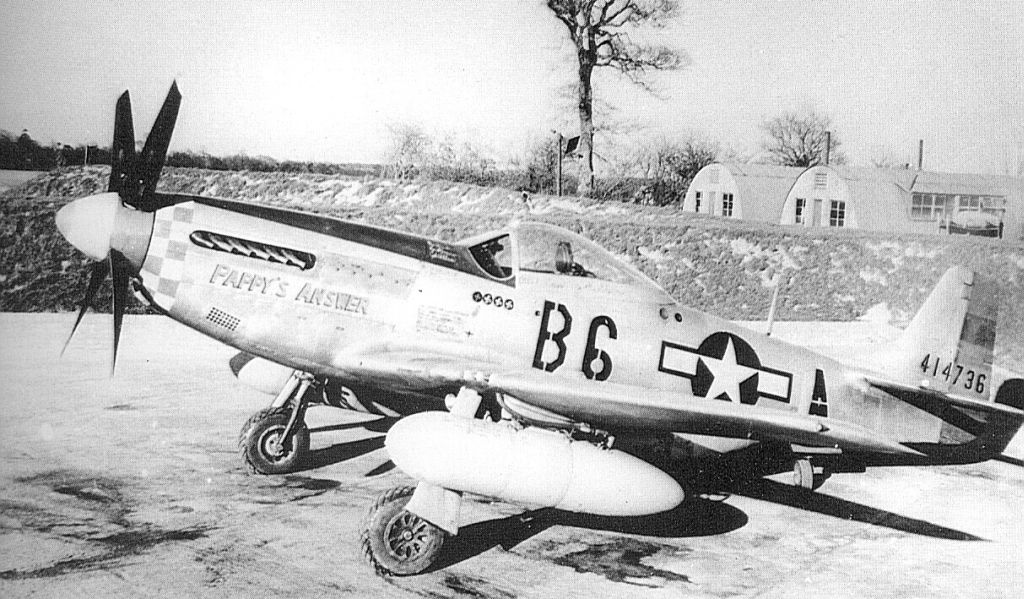
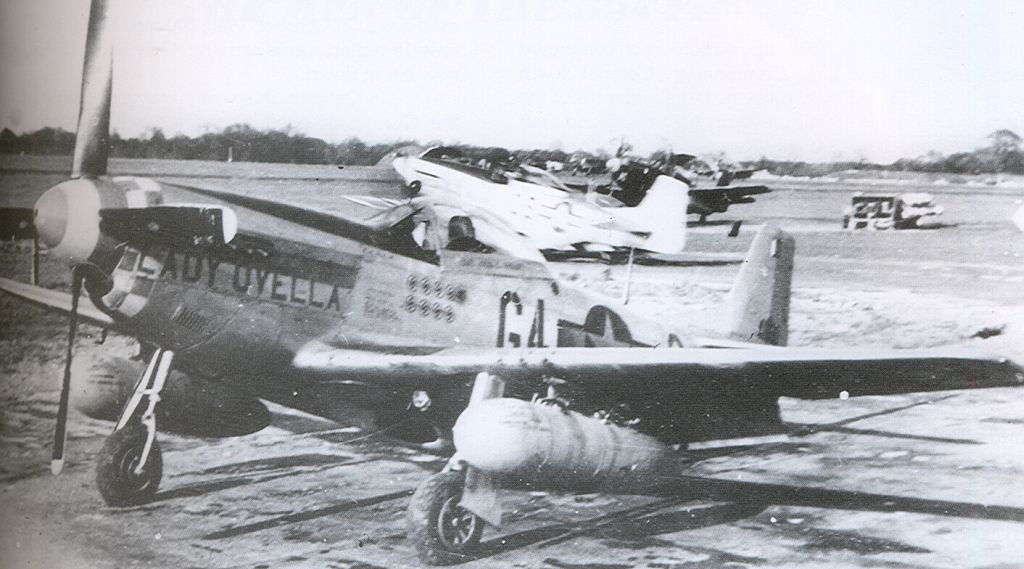
Regards Duggy
Post a reply
- Go to Previous topic
- Go to Next topic
- Go to Welcome
- Go to Introduce Yourself
- Go to General Discussion
- Go to Screenshots, Images and Videos
- Go to Off topic
- Go to Works in Progress
- Go to Skinning Tips / Tutorials
- Go to Skin Requests
- Go to IJAAF Library
- Go to Luftwaffe Library
- Go to RAF Library
- Go to USAAF / USN Library
- Go to Misc Library
- Go to The Ops Room
- Go to Made in Germany
- Go to Campaigns and Missions
- Go to Works in Progress
- Go to Juri's Air-Raid Shelter
- Go to Campaigns and Missions
- Go to Works in Progress
- Go to Skinpacks
- Go to External Projects Discussion
- Go to Books & Resources
